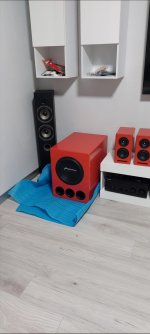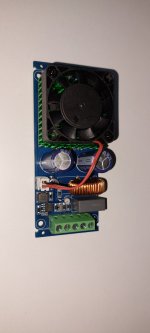Each of the two subwoofer enclosures seem to be about 60 litres internal volume. Gross volume is probably in the vicinity of 80 litres.In the description it says " parameters optimized for small enclosures. " I was thinking about 70 - 90 liters , tunned at 26 - 28 hz .
Found some videos, this guys used huge enclosures.
That's true. But this driver is designed for "smaller" enclosures. The trade-off is sensitivity.84dB sensitivity not so much.
The 4-ohm version nominally draws twice as much power. The difference in Fs would be largely explained by the lower moving mass: Fs = 21.5*sqrt(327/251) = 24.5Hz. This is a bit under the quoted Fs=26Hz for the lighter driver.The 4ohm version has 90.5db sensibilit , and mms 251g – 327g on the 4+4 dual voice coil,
Fs from 21.5Hz on the DVC up to 26Hz on the single coil version.
Using Fb=26Hz results in a peaked bass response near the cut-off frequency. I would tend to avoid that sort of design.Would like to build a subwoofer with this driver. Low bass for movies ( bass music like trap, rap, dubstep all types of that sh*t ) also would it be " musical enough" if tunned that low 26hz port ?. . To play up to 80hz or so. Personally I like the low freq bass even on " normal " music,
If we try a 70-litre enclosure tuned to Fb=21Hz, we should get something like the following VituixCAD simulations. This is for a nominal 100W re 8 ohms input power.
At 100W, we are well below Xmax for this driver, but vent turbulence could be a problem, depending on the port design. However, as your music examples seem to not go lower than 30Hz, we do appear to have a bit of a safety margin at that lower limiting frequency. Of course, the VituixCAD simulation was for a circular port, so the slotted port used in the subwoofers in the YouTube video can have less turbulence due to its larger area, but it needs a longer length.
A VituixCAD simulation with the subwoofer tuned to Fb=22Hz produces the following results, for a nominal 30W re 8 ohms power input. Note that a Linkwitz–Riley 4th-order low-pass filter set to 80Hz has been included. This tuning produces a nice and extended low-frequency response, with a −3dB point of F3=19.4Hz.@jaakkopetteri Low bass is what I was looking for too. Well until I put some money aside for something good, 4 subs or whatever I end up doing.
I got a car sub from Pioneer.
Qms seems a bit high.
100 liters box tunned at 27Hz gives –3dB at 22Hz .
Might sound good for a home theatre sub and low bass music.
A tuning with Fb=27Hz produces a much more peaky response, as shown below. This may not be as easy to integrate smoothly with the main stereo loudspeakers.
Out of curiosity, I did a frequency analysis of the music. It seems that there was lots of low-frequency content between 28Hz and 38Hz, where many of the waveforms are very sinusoidal looking. See the frequency response plot below for details. The subwoofer will certainly be earning its keep, and keeping these types of low frequencies out of the main stereo loudspeakers will also help them to perform better.Found some videos, this guys used huge enclosures.
Last edited:
@witwald Getting a plate amp would be wise. I use the "500w" irs2092 module at the moment , with a low pass https://sound-au.com/project123.htm
Attachments
Sorry I did not understand, what do you mean by this ? .You've reaped the benefits of choosing a large enclosure
I believe he meant you simply compromised on size to achieve your goal……..you chose a large enclosure and an inexpensive driver. To go lower and louder in a smaller box, you would have had to spend more $$$ on a driver…….the resonant air chamber within your 100l allowed for this.
@witwald also shared with you the common music bass content waveform showing how much LF is centered around 30hz or so. For many, this is the reason why sealed subwoofers or stand alone home speakers with an F3 around 40hz are so appealing for music………the acoustic roll off works nicely with the room for music.
@witwald also shared with you the common music bass content waveform showing how much LF is centered around 30hz or so. For many, this is the reason why sealed subwoofers or stand alone home speakers with an F3 around 40hz are so appealing for music………the acoustic roll off works nicely with the room for music.
All I meant was that you had gone for a significantly larger enclosure than the lower limit of 70 litres that you had originally mentioned. The larger enclosure makes it easier to achieve good low-frequency extension with reasonable efficiency, and luckily the Pioneer woofer has the appropriate Thiele–Small parameters to work well in the enclosure that you used.Sorry I did not understand, what do you mean by this ? .
As it happens, if you entirely block one of the ports, you will achieve an even lower tuning and more extended bass response. Below are the VituixCAD simulations for such a 2-vent configuration, with an 80-Hz 4th-order Linkwitz–Riley low-pass filter included, played at 80W re 8 ohms of input power. As can be seen, blocking one vent has lowered the tuning frequency down to Fb=21.8Hz, producing an f3=19.2Hz and f6=17.8Hz. This lower cut-off frequency compared to the 3-vents-active case may help to better reproduce the LFE signal when movies are playing.
Last edited:
I understand your concerns about exceeding Xmax for the TS-W32S4. If you get a plate amplifier with some DSP included, you can add a high-pass filter to reduce woofer excursion below the tuning frequency.
Below is a simulation of the woofer displacements obtained with 2 and 3 vents active. These were computed at an input power corresponding to 80W re 8Ω. The 2-vents active case does have more displacement at 30Hz, but the vents are working a little bit less hard.

Below is a simulation of the woofer displacements obtained with 2 and 3 vents active. These were computed at an input power corresponding to 80W re 8Ω. The 2-vents active case does have more displacement at 30Hz, but the vents are working a little bit less hard.
@witwald Is the 22mm one way or total excursion?.
The Pioneer sub says 11mm xmax but that is one way. ( I think ) they don't specify.
I've tested free air at low frequencies ,
the sub moves around 1 inch (" cone out to in "to say so ) without mechanical noise . The coil won't hit the bottom magnet plate. I was impressed with the excursion and no mechanical noise for a sub this price.
The Pioneer sub says 11mm xmax but that is one way. ( I think ) they don't specify.
I've tested free air at low frequencies ,
the sub moves around 1 inch (" cone out to in "to say so ) without mechanical noise . The coil won't hit the bottom magnet plate. I was impressed with the excursion and no mechanical noise for a sub this price.
The plots are for one-way excursion. That's typically the convention used for Xmax, which Small defined as the "peak linear displacement of driver diaphragm". I just fed the Xmax into VituixCAD from the specifications that were provided. The Xmax=11mm value in the specifications seems typical of this class of woofer driver.
- Home
- Loudspeakers
- Subwoofers
- Dayton Subwoofer

